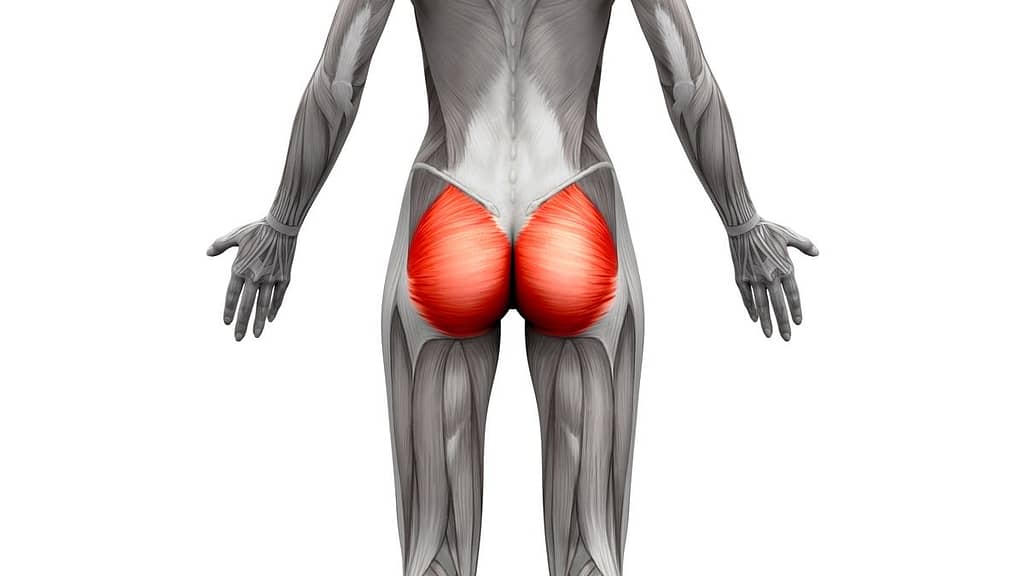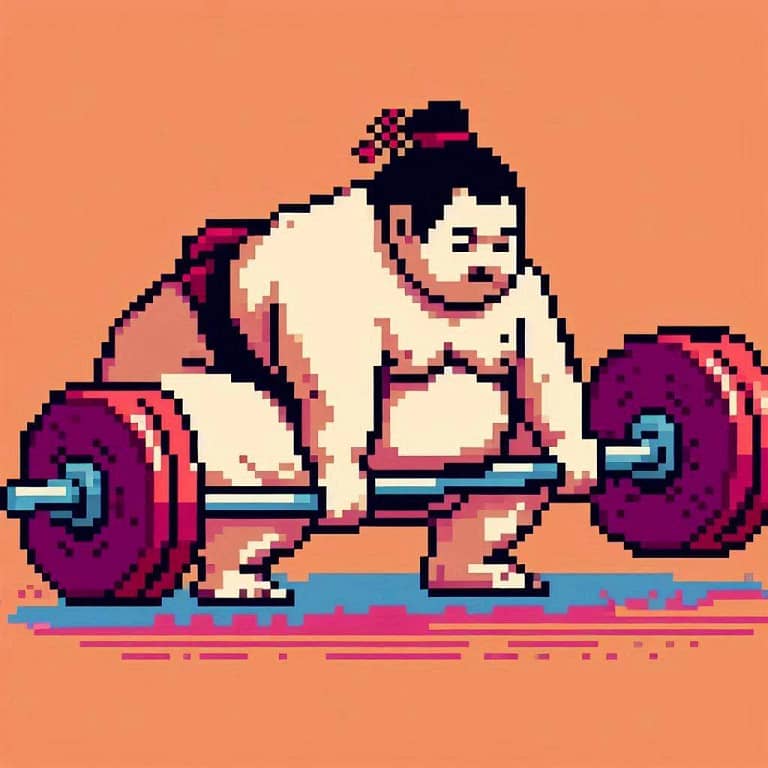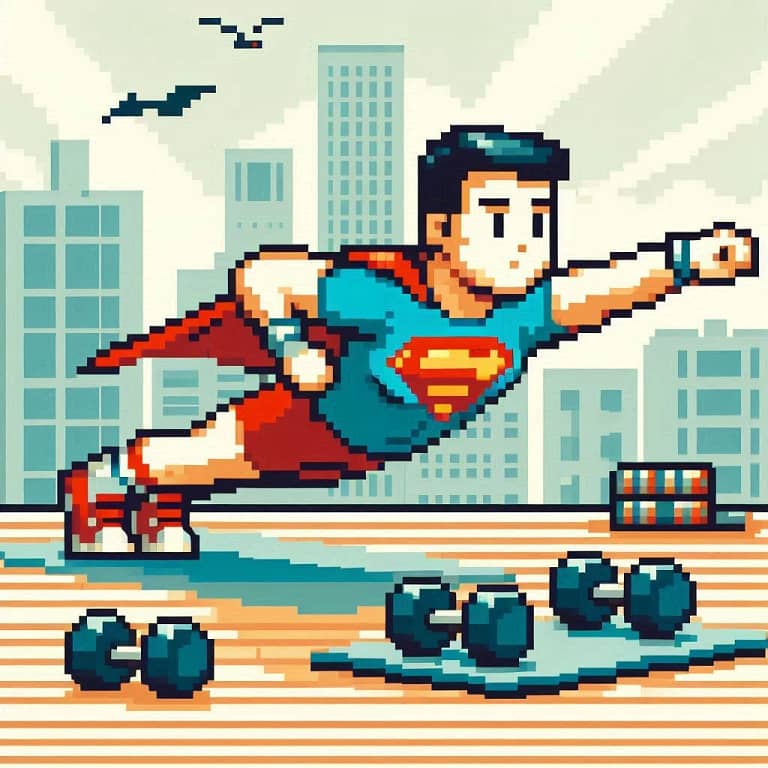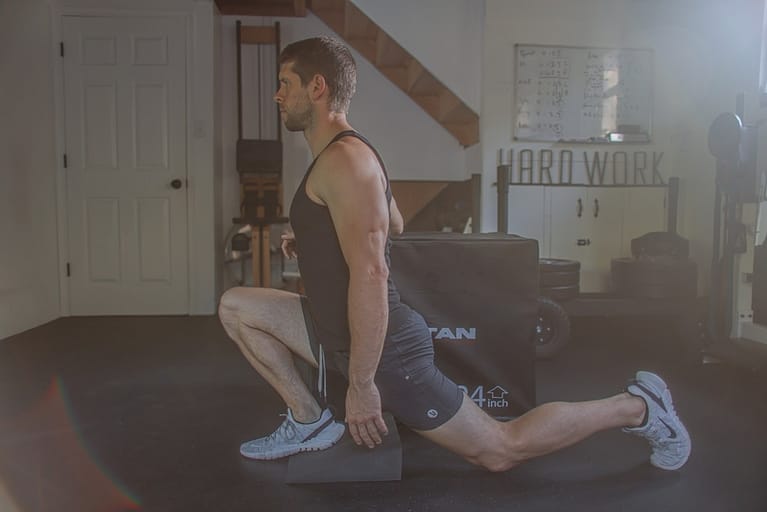Fixing your Lower Back and Sacroiliac (SI) Joint by Targeting One Muscle
You can fix your lower back and sacroiliac (SI) joint by targeting the largest muscle in your body. What do you think is the biggest muscle in the human body?

Would you guess that it is your butt muscles?
The gluteus maximus is not only be the biggest, but possibly the most important muscle in terms of stabilizing the spine, helping us keep an upright posture and overall athletic ability.
But for whatever reason, the gluteus maximus can also be prone to inhibition which can lead to movement compromises and ultimately chronic joint pain. This makes it imperative that you train your glutes intelligently.
“The gluteus maximus is not only be the biggest, but possibly the most important muscle in terms of stabilizing the spine”
Warning:
As always, consult a medical professional if you think there is something wrong!
Fixing your Sacroiliac Joint through your Glutes
The gluteus maximus is an amazing muscle responsible for stabilizing the lower back, the sacroiliac joint and the pelvis. It even can affect your knees and ankles if not functioning properly.
But its most important role is allowing the sacroiliac joint to remain stable and helping it to translate forces to the lower limbs during weight bearing activity. The SI joint is not meant to move much. It should be a stable joint and when it is forced to be mobile, it can be a root cause of lower back pain.

Individuals with SI joint dysfunction usually complain of lower back pain and lumbar spinal pathologies. Glute inhibition or weakness is usually seen in these individuals as well.
Why is this a problem? When the glutes become weak or inhibited, movement compensations can occur at the sacroiliac joint, which is not meant to have a lot of mobility, leading to further injury and subsequent lower back pain.
Unfortunately, the glute muscles are prone to inhibition due to various factors. But if the glutes are working correctly, proper function of the SI joint can be restored/maintained, possibly resulting in less lower back pain symptoms.
The bottom line is, if you are dealing with lower back pain or want to make sure you avoid having chronic lower back pain, the gluteus maximus muscles should be a prime focus in your training.
Reasons for Glute Dysfunction
As mentioned above, the glute muscles are prone to inhibition or “shutting down” for lack of a better word. This can happen because of an injury or misalignment of the pelvis.
The two main reasons for glute dysfunction are tight hip flexors and a loss of external rotation of the hip. Both of these are usually caused by prolonged periods of sitting. Read more about sitting and hip flexion here.
Let’s start by reclaiming the necessary range of motion and ability to contract the glutes with these two stretches.
Couch Stretch
Tightness of the hip flexor muscles is a major cause of glute dysfunction along with weak core muscles. This is because of the anterior pelvic tilt that we get stuck in, putting the glutes in an elongated and disadvantageous position. Studies have shown that people with overly tight hip flexors have half the ability to contract the glutes.
If you are experiencing difficulty “feeling” your glutes during training, then your hip flexor muscles are probably overly tight. To be honest, that is true for most people because of the amount of time spent sitting. The couch stretch can be utilized to loosen the hip flexors and allow for better pelvic control.
The couch stretch is an effective yet painful stretch. Kneel with one knee down in front of a wall and slide back until you can place your leg vertically on the wall with your toes pointing straight to the ceiling. Try to keep your torso upright and you will feel a major stretch in the hip flexor (might feel like your quad) of the leg that is against the wall. Try to hold this stretch for a minute on each side.
You can also put your leg on a couch instead of the wall, allowing your toes to relax which for some reason makes the stretch much more manageable.
Couch Stretch:1-3 sets of :60 each side
Piriformis Stretch
Tight glutes can cause a loss of hip external rotation. When you sit on a chair and cross one leg over the other, the leg that is crossed over is in external rotation. If you are missing external rotation, you will have a hard time getting your shin perpendicular to your body.
The piriformis stretch can help you reclaim hip external rotation and relieve pressure on the sciatic nerve, allowing your glutes to work properly.
Place the outside of your shin on a box or a bench. You can brace yourself by putting your hands on either side of your front leg. Your back leg can simply bend or stay straight depending on the height of the box you’re using.
From here, simply bring your chest towards your knee to feel a deep stretch in the glute muscle of the leg that is up on the box.
If this stretch is too painful for you, try placing a pad or pillow underneath your knee so that the stretch isn’t as deep.
Piriformis Stretch:1-3 sets of :60 per side
Strong Glutes
Now that we’ve activated the glute muscles and reclaimed the necessary external rotation for them to function properly, it’s time to strength train.
Remember that the gluteus maximus is the largest and (should be) the strongest muscle you have. So you are going to want to implement exercises that allow you to use heavy load to simulate growth. We will be using barbells for all of these movements.
Barbell Hip Thrust
Find a bench or box 12-24 inches off the ground. Sit on the floor with your upper back on the bench. With your feet shoulder width apart and toes slightly turned out, you are going to extend your hips up towards the ceiling while squeezing your glutes the entire time. Make sure to initiate the movement with your glutes by scooping your hips under rather than overextending at your lower back.
Place a barbell with weight on your hips for extra resistance. You can really overload the glutes with this movement!
Pro tip: you may feel your glutes even more by turning your feet out more. Play around with the foot position to see what works best for you. Aim for 25 repetitions and tell me that ass don’t burn!
If you’re not ready for heavy load yet, then simply put a booty band around your legs and perform them while trying to keep your knees from caving in. You can also perform these bridges on the floor.
3-5 sets of 15-25 reps
Hip thrusts work very well in conjunction with…
Sumo Deadlifts
Sumo deadlifts allow you to get your legs wider and outside of your hips for a more hip dominant pull off the floor. You can keep your torso more upright in a sumo deadlift versus a conventional deadlift where your feet are shoulder width apart.
Stand in front of the barbell with your legs wider than hip width and with your feet turned out to 45 degrees. You can turn them out more if you feel more comfortable. Bend at your knees and try to widen your legs so that your knees bend wide rather than in front of you so that you can get closer to the bar. Reach down for the bar and perform your deadlift with a more upright torso.
If you struggle to reach the bar, try elevating the bar to you by placing weight plates under it or pull from a pin in a squat rack.
Sumo deadlifts are uncomfortable for some because they lack the mobility to perform them effectively. For others, it’s considered cheating. All I’m going to say on the matter is this… our bodies are all different and sumo deadlifts feel more comfortable for me than conventional deadlifts. Whichever works best for you, and by that I mean, whichever allows you to feel your glutes and hamstrings better, is the one that you should implement into your training.
Sumo Deadlift: 3 sets of 8-10 reps
Because your strength should be relatively similar between the barbell hip thrust and the sumo deadlift, you can possibly perform a superset using the same bar weight
Good Mornings
With a bar on your back (like in a barbell back squat setup) and with a slight bend in your knees, hinge at your hips and try to reach and touch the wall behind you with your butt.
You should feel tension in your glutes and hamstrings as you descend with the bar. Try to keep your shoulder blades retracted and look forward as you descend. Once you reach a point where your hamstrings and glutes feel tension, hold the position for a brief moment before squeezing your glutes to return to the start position.
I usually recommend starting with an empty barbell and only descend until your torso is at 45 degrees relative to the floor. From here you can decide whether you want to go lower based on your comfortability level.
3 Sets of 10-15 reps
Booty Band Back Squats
The back squat is already a great glute builder. But we can make it an even greater glute exercise by simply adding a band around the legs.
Place a booty band around your legs just above your knees. Set up like you normally would with a back squat, but this time when you descend, slowly push your knees out against the tension of the band. You will feel more and more tension in your glutes as you continue to push out against the band. Lower yourself to almost parallel to the floor and hold for a split second before forcefully pushing your heels into the ground to return to the start position. Try to take 3-5 seconds during the descent.
These will have your glutes sore for days!
3-5 sets of 5-10 reps
Fixing your Back and Sacroiliac Joint
I continue to see many people neglect their glute training in the gym. This is a terrible mistake because the glutes are so important for spinal health and overall athletic performance.
If your glutes aren’t working properly, then your low back and hamstrings will be forced to compensate and you are heading for a world of hurt. Train them 1-2 times per week properly and you can avoid this.
“If your glutes aren’t working properly, then your low back and hamstrings will be forced to compensate and you are heading for a world of hurt.”
Training Your Glutes
| Training Protocol (2 times per week) | ||||
| Focus | Exercise | Sets | Reps | |
| Mobility | Couch Stretch | 1-3 | :60 Each | |
| Piriformis Stretch | 1-3 | :60 Each | ||
| Strong Glutes | Exercise | Sets | Reps | |
| Superset A | ||||
| Glute Bridge | 3-5 | 15-25 | ||
| Sumo Deadlift | 3-5 | 5-10 | ||
| Superset B | ||||
| Good Morning | 3-5 | 10-15 | ||
| BB Back Squat | 3-5 | 5-10 | ||
Key Takeaways
References
- Added MAN, de Freitas DG, Kasawara KT, Martin RL, Fukuda TY. Strengthening the gluteus maximus in subjects with sacroiliac dysfunction. Int J Sports Phys Ther. 2018 Feb;13(1):114-120.
- Alexander KM, LaPier TL. Differences in static balance and weight distribution between normal subjects and subjects with chronic unilateral low back pain. J Orthop Sports Phys Ther. 1998 Dec;28(6):378-83.
- Barros G, McGrath L, Gelfenbeyn M. Sacroiliac Joint Dysfunction in Patients With Low Back Pain. Fed Pract. 2019 Aug;36(8):370-375.
- Buckthorpe M, Stride M, Villa FD. ASSESSING AND TREATING GLUTEUS MAXIMUS WEAKNESS – A CLINICAL COMMENTARY. Int J Sports Phys Ther. 2019 Jul;14
- Hossain M, Nokes LD. A model of dynamic sacro-iliac joint instability from malrecruitment of gluteus maximus and biceps femoris muscles resulting in low back pain. Med Hypotheses. 2005;65(2):278-81.
- Jeong UC, Sim JH, Kim CY, Hwang-Bo G, Nam CW. The effects of gluteus muscle strengthening exercise and lumbar stabilization exercise on lumbar muscle strength and balance in chronic low back pain patients. J Phys Ther Sci. 2015 Dec;27(12):3813-6.






